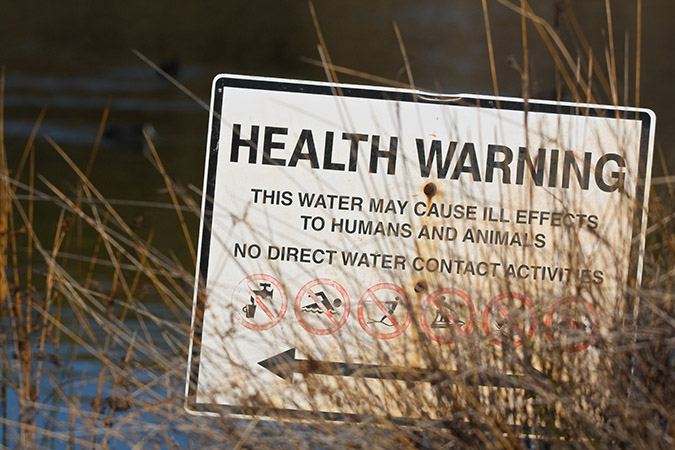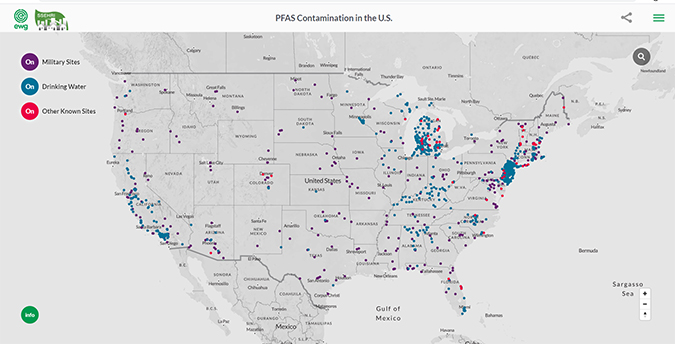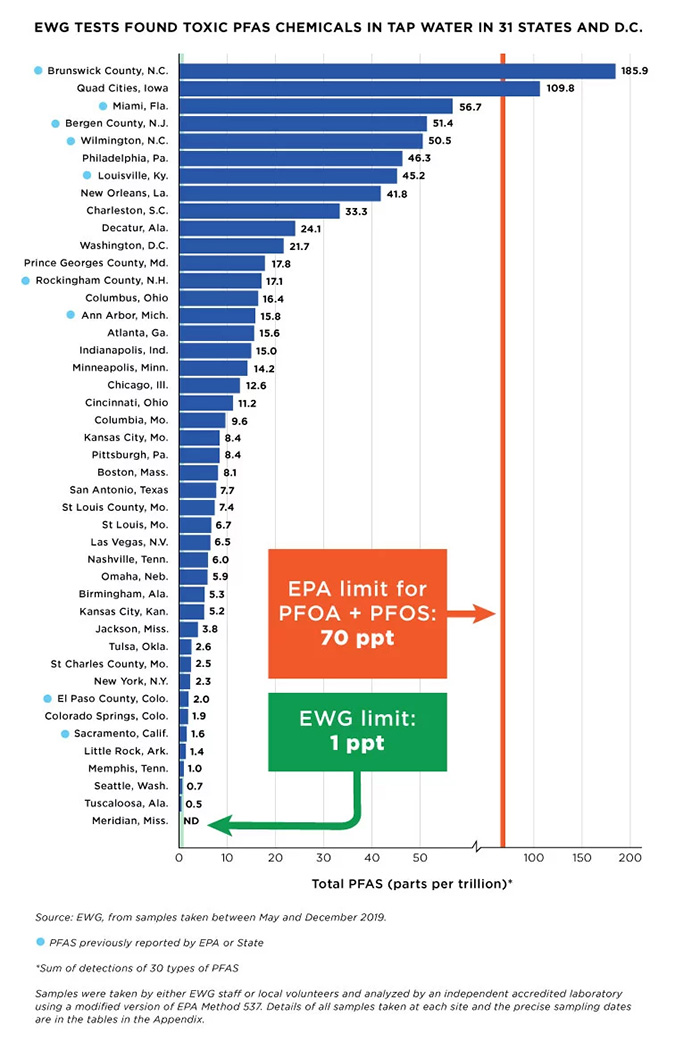PFAS – regulatory trends worldwide
This is the second article in a three-part series considering the challenges PFAS (per or poly fluorinated alkyl substances) present to the environment and potential options for overcoming such challenges. Part I of this series can be found here.
The thermal stability and chemical inertness of perfluoroalkyl substances (PFAS) has led to these man-made chemical compounds becoming ubiquitous and pernicious global pollutants. The common PFASs that are of concern to the environment and human health are perfluorooctane sulfonate (PFOS), perfluorooctanoic acid (PFOA) and perfluorohexane sulfonate (PFHxS). PFOS, PFOA and PFhXs have an estimated half-life of 41 to 92 years in water and 2-7 years in the human body.
According to the U.S. EPA and UNEP (United Nations Environment Programme), PFOS and PFOA are persistent, bioaccumulative and toxic, and EU REACH deem PFOS and PFOA to be substances of very high concerns (or SvHC).
The oceans constitute the primary global reservoir for PFAS where concentrations of PFOA have been determined to be 10-80 pg/L in open waters but can be significantly higher near industrial areas, along the coast, or downstream from an airport. Long-range mobility occurs predominantly through oceanic currents for water soluble PFAS, but also through the atmosphere for more volatile varieties. Further, PFAS adsorb into soil and sediments, where they can be subsequently released into surface and ground waters and taken up by agricultural crops.
While acute toxicity of PFAS is low, a range of adverse effects has been observed in animal studies, such as effects on the liver, decreased thyroid hormone levels, effects on lipid metabolism, development of tumors in one or several organs, and immunotoxicity and developmental toxicity. In humans, PFOS and PFOA has been associated with increased cholesterol levels impact on infant birth weights, effects on the immune system, increased risk for cancer and thyroid hormone disruption.
Exposure to PFOA and PFOS during pregnancy has been demonstrated to reduce fetal and post-natal growth, as well as increase infant mortality. This is especially alarming because these effects have been observed at lower concentrations of PFOA and PFOS.1
The presence of PFAS in the ecosphere is pervasive and persistent, but due to biomagnification, concentrations tend to increase with trophic level. For people, apex predators at the top of the food chain, the primary avenue of PFAS toxicological exposure is drinking water and food. The source could be contaminated, like PFAS contaminated water, shellfish from polluted waters, or the PFAS chemicals can migrate from manufacturing processes with PFAS-contaminated waste discharges. Food packaging can also be a source of contamination. Packaging for microwave popcorn is notorious in this regard.
According to the National Health and Nutrition Examination Study (NHANES), as of 2014, the highest median blood concentration within this class in the U.S. was perfluorooctane sulfonic acid (PFOS) at 5.2 ng/mL, followed by PFOA at 2.1 ng/mL.
Because of the ubiquity and persistence of PFAS in the environment and its long half-life in both the environment and humans, the human population all over the world shows evidence of PFAS in their body, and there is no absolute unexposed control population to evaluate for epidemiological studies. Thus, it is difficult to establish effects on human health due to these normal levels of exposure.
Regarding elevated exposure of PFAS in the human body, the C8 Science Panel concluded there were probable links and association of PFOS and PFOA to high cholesterol, thyroid disease, ulcerative colitis, pregnancy induced hypertension, and testicular and kidney cancers, as mentioned above.
For the above reasons, regulators and policy makers, not only in the U.S., but also in Canada, the U.K., the EU and Australia have taken measures to address PFAS-related environmental and human health issues and concerns.

PFAS contamination in the public waterways has been proven to cause health problems in humans and animals. Photo: iStock/michaelgeorgeau
United States
The U.S. Congress recently approved a new bill to authorize the National Defense Authorization Act to help reduce contamination from chemicals in drinking water, and president Trump is expected to sign the bill into law by the end of the year.
Under the new bill, the U.S. Department of Defense is to phase out the use of PFAS in firefighting foams over three years. The bill will have major implications all way down to municipal and airport firefighting operations, as they are expected to follow the Defense’s lead, and influence the use of PFAS firefighting foam use, manufacture and procurement, and the remediation of sites contaminated by PFAS and PFAS firefighting foams.
The bill also advocates a nationwide testing of all drinking water supplies in the U.S. This will result in more information made available to people and communities regarding the levels of PFAS chemicals in their drinking water.
Another significant action taken is the PFAS Action Act of 2019, which would require the U.S. EPA to establish destruction and disposal guidance for a range of materials, including landfill leachate, biosolids, and “solid, liquid, or gas waste streams” from facilities that manufacture or use PFAS.
Currently, the U.S. EPA has implemented a PFAS Action Plan, which is looking into both short-term solutions and long-term strategies. The aim is to provide a multi-media, multi-program, national research, and risk communication plan. This is a response to the extensive public input the agency has received over the past year during the PFAS National Leadership Summit, multiple community engagements, and through the public docket system.
While the U.S. EPA has provided Drinking Water Health Advisory guidelines of 70 ppt for both PFOA and PFOS respectively, it has not set limits for other PFASs of concern, such as PFBS, PFHxS, PFHpA, PFNA, PFDA and GEN-X (a replacement for PFOA in the manufacturing of fluoropolymers).
A number of U.S states implemented limits for other PFASs of concern, such as Massachusetts (20 ppt for a combine Maximum Contaminant Levels (MCL) for PFOA, PFOS, PFNA, PFHxS, PFHpA, and PFDA), Vermont (PFHpA 20 ppt), New Hampshire (11 pt MCL for PFNA), New Jersey (13 ppt MCL for PFNA), North Carolina (GEN-X 140 ppt) and Michigan (GEN-X 370 ppt).
The U.S. states have implemented their own health guideline values for PFOS and PFOA in drinking water values, which are much more conservative and lower than the U.S. EPA Drinking Water Health Advisory guidelines based upon their own toxicology studies. For example, Michigan (PFOS 9 ppt; PFOA 8 ppt), New York (PFOS 10 ppt; PFOA 10 ppt), New Jersey (PFOS 13 ppt; PFOA 14 ppt), Vermont (PFOS 20 ppt; PFOA 20 ppt), and New Hampshire (PFOS 70 ppt; PFOA 38 ppt). It is to be noted that guidelines are mandatory as it is not regulation. However, MCL (or Maximum Contaminant Levels) are legally binding once it is proclaimed by regulation whether it is at federal (by the U.S. EPA) or at state level by the responsible state legislative and regulatory bodies. Once it is an MCL, polluting parts are required to implement remediation and clean up actions and funding can also be obtained from the US Superfund for clean up of contamination sites at both federal and state levels.
Although PFAS is well associated with environmental and human health risks, the U.S. EPA has not taken much regulatory action in regard to management and disposal of PFAS waste, other than having a PFAS action plan and issuance of Drinking Water Health Advisory guidelines for PFOS and PFOA. The U.S. EPA has authority to regulate PFAS wastes under the Resource Conservation and Recovery Act (RCRA), which has a federal statute to ensure that hazardous waste is minimized to protect present and future generation from its threats to human health and the environment. In the absence of a U.S. EPA regulation of PFAS under RCRA, wastes from industrial processes utilizing PFAS are released into the environment in substantial volume, causing both environmental and human health impacts.
On 20 February 2020, the U.S. EPA announced that it is proposing regulatory determinations for PFOS and PFOA in drinking water under its PFAS Action Plan. Under the Safe Drinking Water Act, the EPA is to review unregulated contaminants that may present a risk to public health. The EPA then publishes a list of contaminants, known as the Contaminant Candidate List (or CCL), every fiver years; PFOS and PFOA are now included.

Map courtesy of Environmental Working Group
Canada
In 2018, the Canadian Federal-Provincial-Territorial Committee on Drinking Water of the Federal-Provincial-Territorial Committee on Health and the Environment released a guideline technical document, which reviewed and assessed all identified health risks associated with PFOS and PFOA in drinking water. It incorporated available studies and approaches and took into consideration the availability of appropriate treatment technology. Based on the review, the drinking water guideline for PFOS and PFOA was set at a maximum acceptable concentration (MAC) of 0.6 µg/L (600 ppt) and 0.2 µg/L (200 ppt) ) based on the general population.
Australia
In 2018, at the request of Environment Ministers around Australia, the Heads of EPAs Australia and New Zealand (HEPA) and the then Australian Government Department of the Environment and Energy collaborated to develop a PFAS National Environmental Management Plan (NEMP), which is designed to achieve a clear, effective, coherent and nationally consistent approach to the environmental regulation of PFAS. In the plan, a number of interim health and contamination guidelines were stipulated, such as health-based guidance values (including drinking water and health risks), soil criteria for human health and ecology, terrestrial and aquatic biota. NEMP version 2 is still under revision and it is expected the revised guidelines to be finalized sometime in 2020. The drinking water health guidelines for PFOS and PFHxS is 0.07 ug/L (70 ppt similar to the USEPA); however the PFOA guideline is much higher at 0.56 ug/L (560 ppt). Australia also has various guidelines in the NEMP, which most countries do not yet have. For example, recreational water quality value of 0.7 ug/L for PFOS (700 ppt) and 5.6 ug/L (5600 ppt) for PFOA. It also has ecological protection risk values for various risk levels, e.g., 99% species protection value for PFOS at 0.23 ug/L or 0.23 ppt and 19 ug/L (19,000 ppt) for PFOA for high conservation value systems (currently those values are under review).
UN Stockholm Convention on Persistent Organic Pollutants
In 2001, an international environmental treaty, the Stockholm Convention on Persistent Organic Pollutants, was signed to eliminate or restrict the production and use of persistent organic pollutants (POPs), which became effective from May 2004. In May 2009, the Stockholm Convention was amended to ban nine new chemicals, and the production and use of PFOS, its salts, and perfluorooctane sulfonyl fluoride (POSF) were restricted under Annex B. In April 2019 in Geneva, at the ninth meeting of the Conference of the Parties to the Stockholm Convention (COP-9), PFOA was added to Annex A of the Convention as a restricted chemical of concern, and proposal has been made to include another PFAS of concern, PFHxS. All three of those PFASs are commonly found in PFAS firefighting foams.
European Union
In the EU, PFOS, PFOA and recently PFHxS are restricted under EU REACH regulation as Substance of Very High Concerns (SvHc) and vPvB (very persistent and very bioaccumulative). Recently in the EU, a proposal was made to ban PFAS as a group of chemicals rather than as individual compound like PFOS, PFOA and PFHxS, and health guidance values were issued for an initial group of 20 PFASs. Currently, Denmark and Sweden have drinking water guidance values for collective group of 12 and 11 PFASs respectively, and a value of 525 ppt for PFOS stipulated in the EU Environmental Quality Standards Directive for water in the natural environment and not water intended for human consumption.
Some of its member states have adopted their own PFOS drinking water guidelines, e.g., Sweden 90 ppt, Denmark 100 ppt as mentioned above, the Netherlands 530 ppt (for surface water extraction for drinking), and Germany has various guidelines for infant and the general population ranging from 100 ppt to 500 ppt. The U.K. PFOS drinking water guideline is 100 ppt as a trigger value action to safeguard safe drinking water.
On September 2, 2019, the Danish Ministry of Environment and Food announced that the Danish government will ban the use of per- and polyfluoroalkyl substances (PFAS) in paper and cardboard used in food contact materials by July 2020. “We will [ban them] because I will not accept the risk of these very harmful substances migrating from the packaging to the food. We can see that the substances represent a major health problem and we can no longer wait for the EU,” said Danish Food Minister Mogens Jensen.

Courtesy of Environmental Working Group
Challenges
There are numerous challenges to implement and monitor compliance to the above-mentioned regulations and policies such as:
Evolving information regarding the environmental and human impact of PFASs as a singular compound and PFASs as a group. Currently information pertains mainly to PFOS and PFOA and recently PFHxS, and yet there are thousands of various PFAS compounds with different CAS (Chemical Abstracts Service) Registry Numbers. There are now over 4,700 CAS registered PFAS compounds being used in products and industries. Furthermore, there is also debate regarding the risk of PFASs to human health, such as whether PFAS cause human cancer.
Resources to implement and monitor the various PFAS Action Plan, regulation and policies to ensure compliance.
Some countries (although few) have yet to ratify Stockholm Convention on POP to include PFOS and now PFOA in its annexes.
PFAS manufacture and usage is a billion dollar industry and there are lobby groups advocating for its continual use.
Many involved in the PFAS space (regulators, policy makers, users, manufacturers, media and the community) are still playing catch-up to understand the impacts upon the environment and human health and the extent of PFAS contamination and use in our everyday products.
The challenges for many is now how does one deal with the problem. Are there technologies to reduce its impact, remove it completely from the environment and affected humans.
As mentioned in Part I of this series, there are now various PFAS removal and treatment technologies commercially available to remove and destroy PFASs, such as filtration using micro-, nano- and ultrafiltration, GAC (granulated activated carbon), ionic exchange resins and adsorption media, reverse osmosis and others, as high thermal incineration, pyrolysis and electrochemical oxidation to destroy the C-F bonds of PFASs, to render them inert and safe.
Part III of this series will examine some of the potential solutions to the PFAS challenge in more detail.
Part I of this article can be found here.
References
“Per and poly-fluoroalkyl substances,” Government of Western Australia Department of Health, https://ww2.health.wa.gov.au/Articles/F_I/Guidance-Statements-on-Perfluorinated-Chemicals.
Source: The information is copied from Filtnews

 Photo: iStock/Sviatlana Lazarenka
Photo: iStock/Sviatlana Lazarenka
